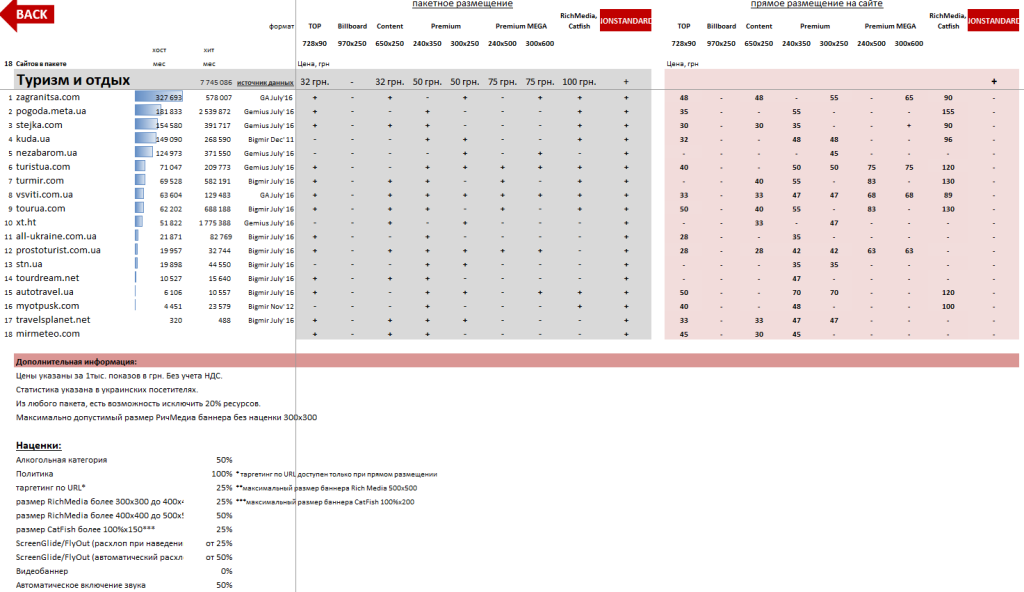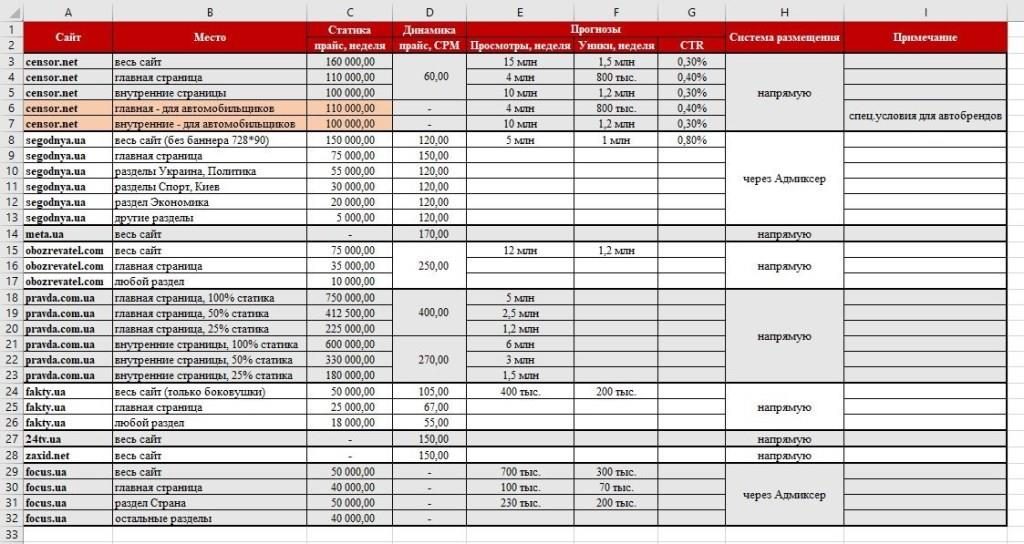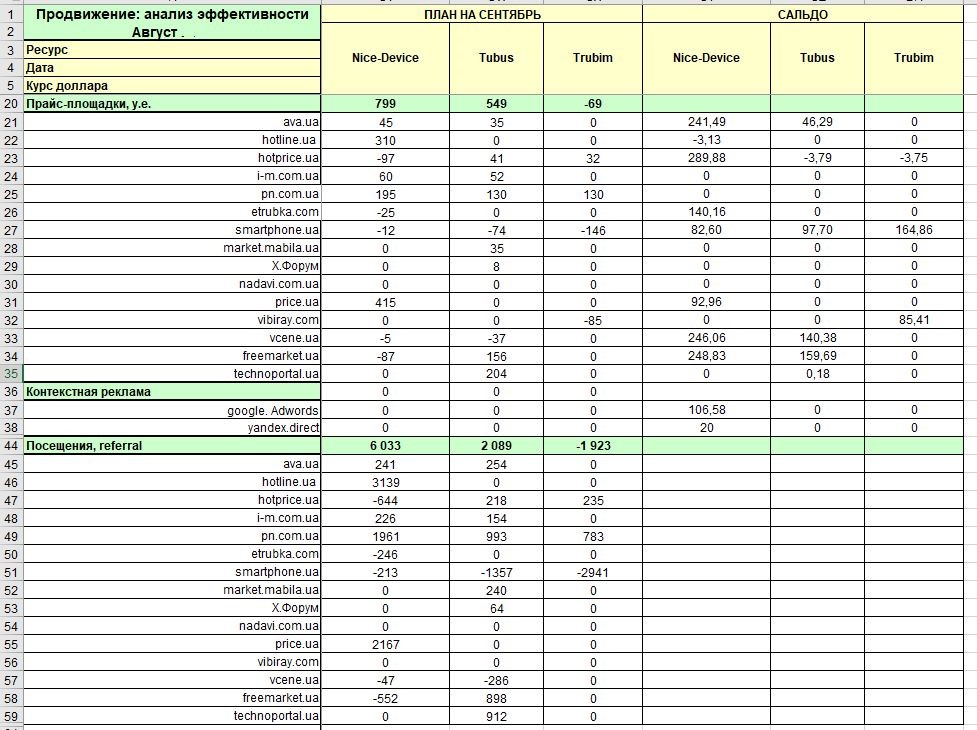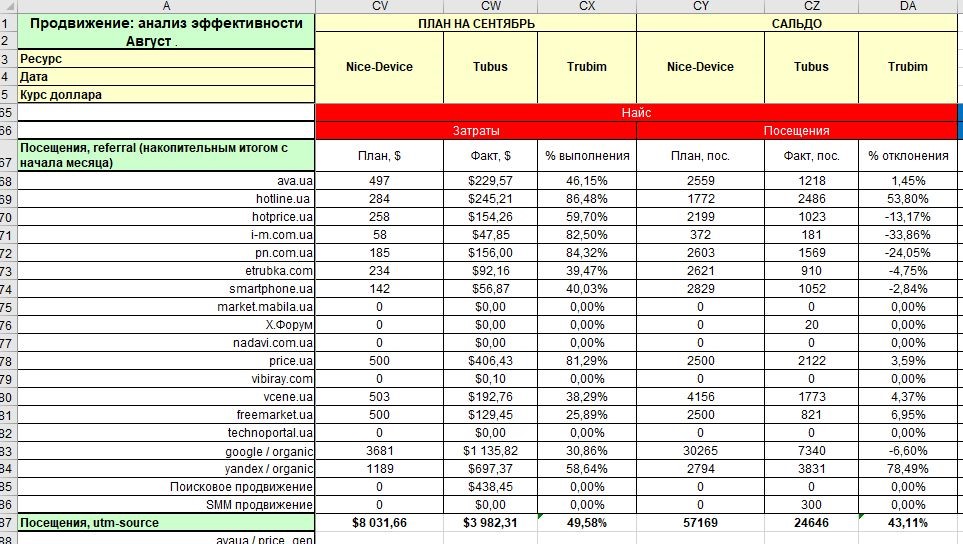Что такое медиаплан и как его составить?
К нам в компанию достаточно часто обращаются Клиенты, которые впервые слышат о медиапланировании именно от нас. Большинство наших коллег либо не знают про медиаплан либо просто пренебрегают им. В итоге скорректировать свою работу и выполнить анализ эффективности становится практически невыполнимой задачей. А расплачивается за это всё разумеется Клиент.
Что такое медиаплан и медиапланирование?
Для начала давайте разберемся, что же такое медиаплан.
Медиаплан – это подробный план проведения рекламной компании. В него входят сроки, необходимый бюджет и площадки, на которых будет размещаться реклама. Обычно медиаплан представлен в виде таблицы.
К медиапланированию относится процесс подбора видов рекламы и рекламных площадок. Благодаря ему нам проще анализировать успешность кампании и понимать, какой результат дает та или иная площадка. Медиапланирование основывается на полученных результатах, которые видны на фоне прогнозов и помогает сделать нашу работу более эффективной.
Для чего составляют медиаплан?
Грамотно составленный медиаплан позволит избежать досадных ошибок, которые влекут за собой «слив» бюджета.
Всеми любимый Чендлер из сериала «Friends» после покупки нового телевизора говорил: «Наконец-то мы сможем посмотреть рекламу прокладок по-человечески».
Сейчас, увы, это не работает. Просто оплатить рекламу по TV мало. Конкуренция выше, маркетологи умнее, таргетинг, контекст, нейромаркетинг и т.д.
Именно поэтому значение грамотного медиаплана нельзя недооценивать.
Мы составляем медиаплан для:
- точной оценки имеющихся финансовых ресурсов в разрезе стоимости площадок;
- установки сроков всех рекламных кампаний;
- создания четкого плана работы с рекламой;
- увеличения охвата целевой аудитории;
- оценки эффективности рекламных кампаний и корректировки своей работы.
Комплексная стратегия и медиаплан продвижения принесет более весомые результаты, нежели разовые рекламные ходы. Все-таки мы маркетологи, а не слепые коты.
Как правильно составить медиаплан?
Для того, чтобы ответить на вопрос как составить медиаплан нужно запомнить: это должен быть информативный и грамотный документ! Поэтому мы предварительно получаем от Клиента всю необходимую информацию благодаря заполненному брифу.
Мы анализируем полученную информацию от заказчика и обсуждаем все детали.
Для разных целей мы используем разные брифы, от кратких до детальных.
Из брифа мы должны понять главную цель нашей будущей работы, для того, чтобы менеджер проекта при сдаче отчета знал, какие ожидания были у Клиента и оправдали ли мы их. Целью может быть привлечение новых Клиентов, возврат ушедших, повышение узнаваемости, лояльности и др.
Для каждой цели мы будем строить свою стратегию продвижения.
Помимо всего, во время обсуждения брифа мы определяем рынок, целевую аудиторию, географию продвижения, подбираем рекламные каналы и другие инструменты интернет-маркетинга, которые будут задействованы в нашей работе.
Медиаплан – это такой себе ежедневник для менеджера.
В обязательном порядке мы проводим анализ ниши и конкурентов. Как правило, у каждого Клиента есть свое понимание, кто является его конкурентом, а кто нет (есть как прямые, так и косвенные и другие градации). Поэтому мы изначально запрашиваем такой список у заказчика, но обязательно сами находим конкурентов в разрезе каждого направления продвижения. Например, конкурент, у которого развиты социальные сети может не иметь сайта, поэтому нет смысла его брать для анализа в направлении Продвижение в поисковых системах.
Не всегда Клиент, даже превосходно знающий свой бизнес, видит всех своих конкурентов. Глаз замыливается. А мы, как маркетологи, помогаем Клиенту посмотреть на свой бизнес под другим углом.
Когда понятно, кто наша целевая аудитория, где она живет и что она любит, мы определяем бюджет на рекламу. Цена во многом зависит от количества рекламных каналов и объявлений в каждом из них. После их определения, решаем, сколько касаний должен сделать человек, перед покупкой. На это влияют разные факторы:
- какой у нас продукт/услуга;
- сезонный спрос или постоянный;
- бюджет, которым мы можем распоряжаться;
- цель.
В итоге у нас получается готовый медиаплан, по которому мы и начинаем работу.
Резюмируем, что нужно знать для успешного составления медиаплана:
- Сделать анализ ниши. Например, при разработке структуры сайта это просто must have.
- Определиться с целевой аудиторией. По возможности, сделайте карту эмпатии.
- Поставить правильные цели рекламных кампаний.
- Подобрать каналы коммуникаций.
- Сформировать бюджет.
Дальнейшее будет зависеть от проделанных пунктов выше.
Примеры медиаплана рекламной кампании
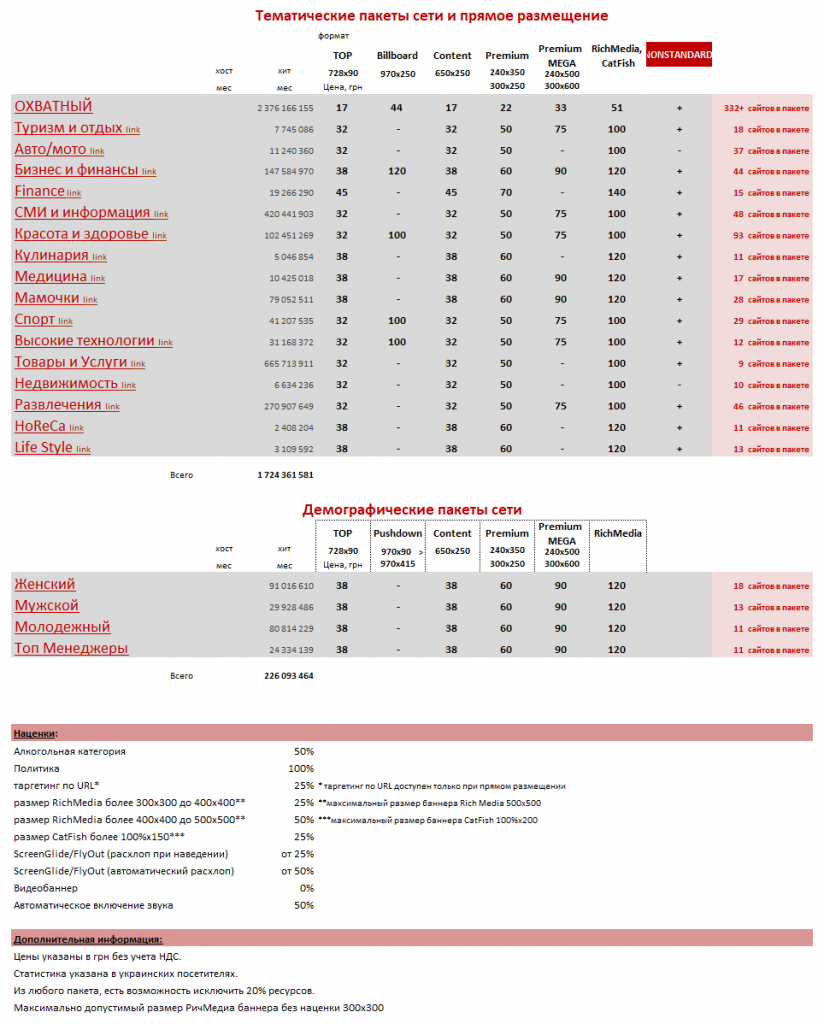
Пример медиаплана от рекламной сети Admixer – мультиформатной сети, объединяющая тематические сайты для проведения различных рекламных кампаний.
Прошу не акцентировать внимание на ценах в примере медиаплана, т.к. они даны лишь для ознакомления со структурой документа.
Медиаплан есть. Что дальше?
Ну вот вы и составили медиаплан, рекламные кампании запущены, Клиент готов считать прибыль.
Звучит все просто, но это еще не все.
После запуска рекламы, начинается самая настоящая шахматная партия. Маркетолог в данном случае выступает в качестве шахматиста, который обдумывает свой каждый шаг, строит стратегию исходя из ситуации и показателей на данный момент и может ее корректировать.
Благодаря сквозной аналитике маркетолог регулярно анализирует, разумно ли тратится бюджет, стоит ли отказаться от какого-то канала продвижения, все ли идет по плану?
Часто бывает так, что в процессе работы выясняется, что один канал неэффективен и бюджет перераспределяется на другие.
Нужно понимать, что каждая ниша уникальна, каждый запуск рекламной кампании тоже уникален, поэтому оптимизация медиаплана в процессе работы практически неизбежна.
Важные замечания вместо заключения:
- Лучше достичь намеченного результата от небольшого числа ЦА, чем совсем ничего не добиться от многих.
- Реклама с частотой вдвое меньше требуемой — это зря потраченные деньги.
- Непрерывная реклама может быть целесообразна, если ее цель – убедить розничную торговлю и ретейлеров, что марка имеет поддержку и заслуживает места на полках магазина.
- При распределении бюджета важно найти оптимальное соотношение между 3 параметрами: охватом, частотой и количеством рекламных циклов, которые нужно осуществить за год. Т.е. у фактически у нас есть выбор: либо редко охватывать каждого потенциального клиента в стране, либо чаще охватывать, но в определенном регионе.
- В условиях дороговизны рекламы нужно использовать любую возможность, чтобы оптимизировать число контактов с аудиторией до минимально эффективной частоты (МЭЧ). Зачастую нет необходимости постоянно охватывать рекламными циклами всю целевую аудиторию. Вместо этого год делится на несколько рекламных циклов, которые проводятся с разной частотой и интенсивностью. Например, для часто потребляемых (FMCG) продуктов необходимо следить за высокой частотой контактов, тогда как для редко приобретаемых товаров (бытовая техника) важно удерживать охват, а интенсивность рекламного воздействия снизить.
- Отреагирует ли ЦА на нашу рекламу, зависит от трех факторов:
- способности самого средства рекламы привлекать внимание,
- размера (продолжительности или площади) рекламного объявления,
- творческого содержания рекламы.
Эксперт в области интернет-маркетинга. Руководитель маркетингового агентства MAVR.
Бизнес-степень «Мастер делового администрирования» (MBA).




